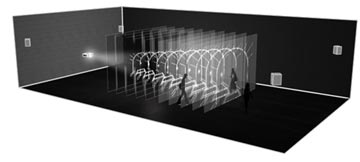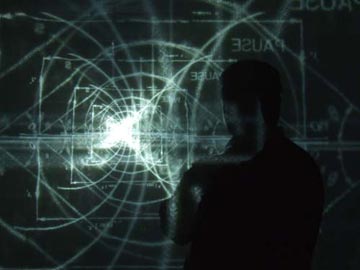[youtube:https://www.youtube.com/watch?v=5C50_R3cDlY]
Paul Warne doesn’t consider himself so much an artist as a designer. While trained in animation and film at the Edinboro University of Pennsylvania, Warne found himself immersed in video game design, video installation and, most recently, creations of “Augmented Reality” (the interstitial space where virtual and the real worlds meet). An artistic mind with a penchant and know-how for the technological, the American (and now Montreal-based) designer has never been shy about creating art experiences that cross media boundaries and involve his audience.

Paul Warne, "Breaking The Ice," telepresence interface, 2010. Courtesy John Desjarlais (photographer).
After working in the video game industry for 10 years (pausing intermittently to focus on independent art projects), Warne found himself creating interactive media installations as well as teaching video game design at Dawson College. His Chamber of Hollowfields, a video-installation of layered translucent screens supporting 3D computer animation, enveloped the viewer in a floating multi-dimensional animated space; the visual adventure manipulated and shifted senses of perspective and reality. Both this project and the Kabaret of Kinomorphosis were featured at the 2008 Art Festival component of the international pop/rock/indie music fest, Pop Montreal. The Kabaret, a single-channel video update of the carnival headboard, went on to be featured in the 2009 Art Pop festival as well as the 2010 Nuit Blanche (an annual night-long celebrating art and music in the dead of winter in Montreal).

Paul Warne, "Chamber of Hollowfields (concept)," multi-channel video installation, 1998. Courtesy the artist.
With his most recent project, Paul has come to realize that his work increasingly calls for collaboration. Warne and computer programmer Mike Wozniewski created Breaking The Ice (shown at the beginning of this post), a system of telepresence featured at the CODE art festival at the Vancouver 2010 Winter Olympic games (with locations in both Vancouver and Montreal). Developed through the Society of Arts and Technologies (a “transdisciplinary centre dedicated to research, creation, production, presentation, education and conservation in the field of digital culture”), the duo created a game environment that allowed people from opposite ends of Canada to meet each other, interact through a large-screen kiosk, and play games, thus “breaking the ice.”
Warne, through his teaching, has come to realize that the work he creates is about how people interact around the work. In a way, Warne is simply continuing John Brockman’s idea of intermedia kinetic environments into the 21st century. It is about creating an experience bringing together art, sound, music, and interactivity (which can take the following form: below is a video of Paul VJ-ing for Montreal band NOIA in 2008 using a multi-screen set-up). The ultimate aim is immersion, involvement, and participation. The work of art lies not within the physical object itself but in the relationships and interactions it fosters.
[youtube:https://www.youtube.com/watch?v=Kv9aHZWYl8I]
At the moment, Warne is smitten and intrigued with the possibilities of “Augmented Reality,” dreaming up the idea of site-specific virtual installations recognizable through physical markers and viewable through smart phone technology (he tried to materialize the volume of oil spilled by BP in virtual space, but found it too large to see completely). Juggling commercial work and independent projects, learning from the tool creation and conceptualization in both areas, Warne ultimately is inspired by the possibilities of new media and technologies. While he labels himself a designer, as a creator, Warne explores the ways people interact with art, inviting his viewers to learn more about themselves and this technological world we now live in. And in the end, isn’t this reflection what art is all about?





Pingback: Game (as) Art: The Kokoromi Collective | Art21 Blog